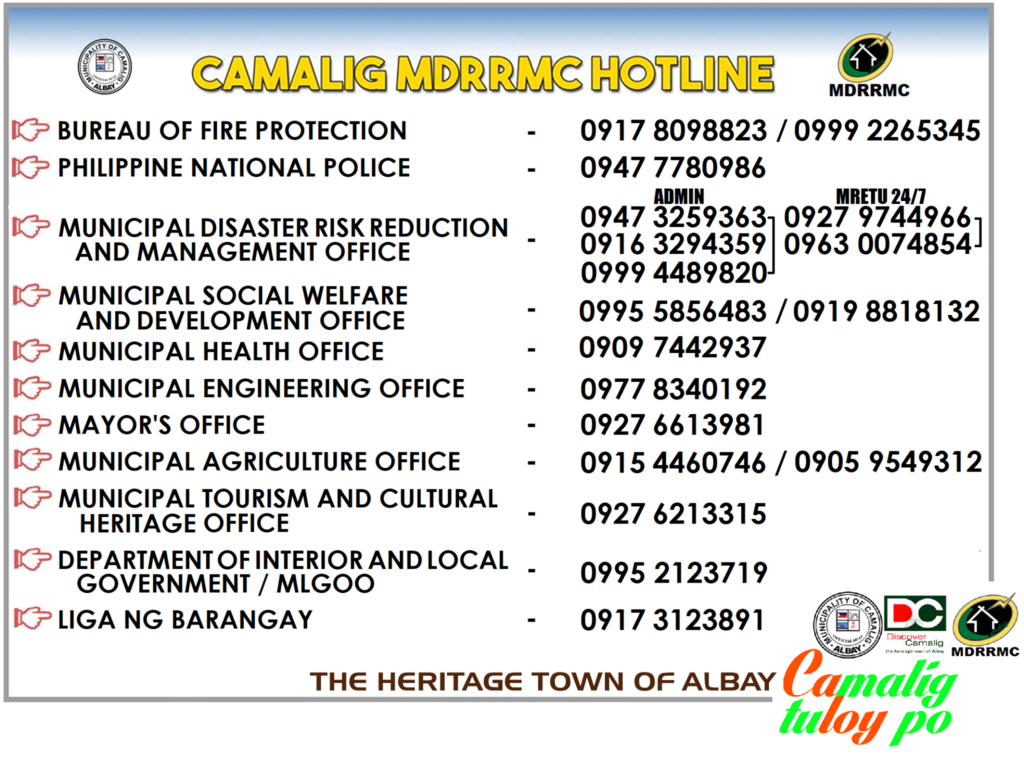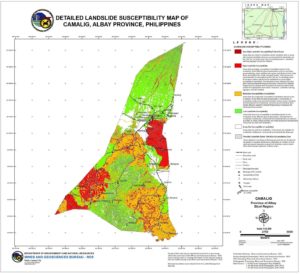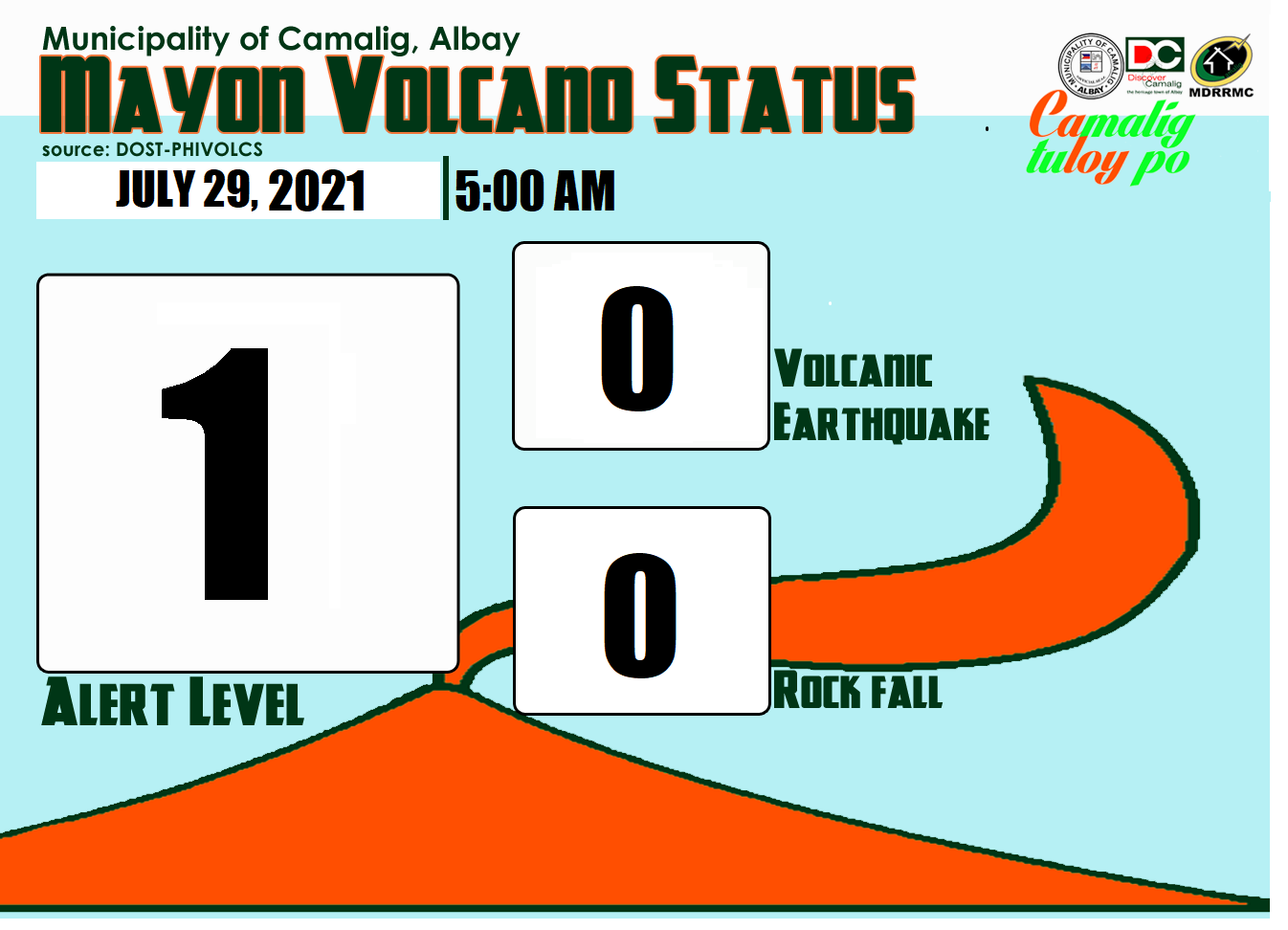
In 2010, the Municipal Disaster Coordinating Council (MDCC) has been revitalized to ensure the capability of the municipality to respond during disasters. Upon the enactment of Republic Act 10121 or the Philippine Disaster Risk Reduction and Management Act of 2010, the existing MDCC has been reorganized as the Municipal Disaster Risk Reduction and Management Council (MDRRMC). With it the creation of the Municipal Disaster Risk Reduction and Management Office (MDRRMO) succeeded.
The MDRRMO Camalig, Albay has five key strategic themes in pursuing prevention, mitigation, preparedness, response, recovery and rehabilitation. These include: citizens satisfaction, internal process, financial, learning and growth. Various strategies were identified to be used in order achieve the desired key result areas, goals and objectives under each DRRM aspect.
These are the following:
1. Advocacy and information, education and communication – achieving this will need increasing visibility and understanding of DRMM and CCA issues, mobilize partnerships, encourage actions and gather public support for successful implementation of the different activities. The MDRRMP will use evidence based advocacy to influence people, policies, structures, and systems in order to build resilient Camalig communities by raising awareness, working with the media and key stakeholders. The MDRRMC/MDRRMO will develop advocacy, IEC and various communication strategies based on risk assessments and good DRRM practices.
2. Competency based capability building – Conducting customized training programs should be developed to ensure that people are trained based on the needed skills in the different DRRM aspects. Different people have different needs and capacities and developing competency-based capability building programs ensures that knowledge, skills and attitudes are enhanced and built upon further.
3. Contingency planning – More commonly used before as only part of disaster preparedness activities, contingency planning is now a living document which is updated and used in all the different the priority areas of DRRM. Learnings from past experiences and complementary actions between and across areas should be taken into consideration in developing contingency planning at all levels.
4. Education on DRRM and CCA for ALL – Mainstreaming DRRM into formal education through the integration of DRRM and CCA concepts in the curriculum for basic education, NSTP, and bachelors’ degree programs. This also includes the conduct of DRRM and CCA training to all public sector employees as mandated by law.
5. Institutionalization of MDRRMC and MDRRMO– The creation of permanent MDRRMO and functioning MDRMMC at the local level are some of the ways to ensure that all DRRM-related activities, plans and programs will be implemented and sustained, especially at the local level. Having a point of convergence is important to ensure that risk reduction measures complement one another and are institutionalized with the end in view of reducing people and intuitional vulnerabilities to disasters.


The MDRRMO as the implementing arm of the Municipal Disaster Risk Reduction and Management Council, shall have the primary mission of administering a comprehensive disaster risk reduction and management program by providing leadership in the continuous development of strategic and systematic approaches as well as measures to reduce the vulnerabilities and risks to hazards and manage the consequences of disasters.
VISION
A highly responsive and proactive town working towards a safe, greener environment and progressive communities.
MISSION
Ensure efficient and effective emergency response and disaster preparedness programs and services with vigorous participation of the fifty barangays and various stakeholders.
GOALS
- To uphold the people’ constitutional rights to life and property by addressing the root causes of vulnerabilities to disasters, risk reduction and management and building the resilience of local communities to disasters including climate change impacts; and
- To adopt measures to protect the inhabitants of the municipality from the harmful effects of man-made or natural disasters and calamities and to provide relief services and assistance for victims during and in the aftermath of said disaster and calamities.
OBJECTIVES
The general objective is to secure the general health and safety of the citizenry to any calamity or urgent situation through efficient disaster strategic plans and actions in coordination with various Disaster Risk Reduction Management stakeholders both in the local and national level. The specific objectives are as follows:
- To advocate for policies on emergency and disaster preparedness.
- To establish systems and protocols on emergency management.
- To strengthen networking intra and inter-agency for emergency and disaster preparedness activities.
- To enhance human resource and their capabilities in emergency and disaster.
- To empower communities and partners on emergency and disaster resiliency, embracing climate change adaptation through integration of system specific actions and methods.
- To ensure availability of logistics, funds and other resources in times of emergency.
RECONSTITUTING THE MUNICIPAL DISASTER RISK REDUCTION AND MANAGEMENT COUNCIL (MDRRMC) IN THE MUNICIPALITY OF CAMALIG, ALBAY, PROVIDING FOR ITS COMPOSITION AND FOR OTHER PURPOSES. [Preview File]

Hazard Maps
- Flood Hazard Map
- Landslide Susceptibility Map
- Camalig Multi-Hazard Map
- Flood Susceptibility Map
- Landslide Susceptibility Map (w/ Permanent Landslide Markers)
Mayon Updates
Mayon Volcano History of Eruption | Population Threatened by Lahar from Mt. Mayon












